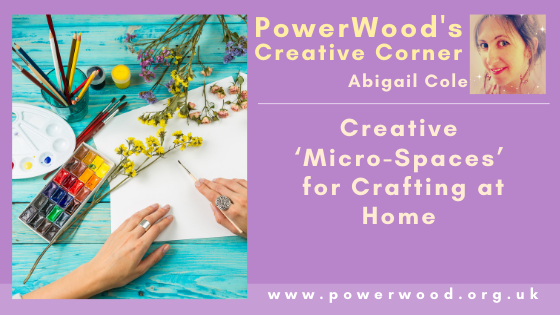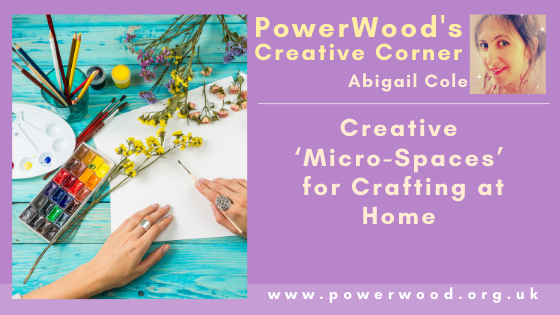
Being someone who is passionate about art and creativity amidst the every day and in particular, family life, I’ve also always been curious about the spaces in which creativity takes place and how they ultimately might affect what we make or whether we make anything at all.
The possibility of having “a room of one’s own” has long been considered a true gift in order to create. But what if a private space in which to work creatively is simply not an option, or even if it is a possibility, a different choice of space seems equally alluring?
There are many practicalities that might inform a decision about a space to use, and from experience, I know that a lack of dedicated creative space doesn’t have to be a limitation at all and can indeed offer many positives and possibilities. With many folk working together from home still this year, in shared and overlapping spaces, I wondered whether a practical exploration of working spaces through the lens of creativity might offer some inspiration.
Communal or Private
Whilst a private, quiet space in which to work is definitely positive in terms of being able to work undisturbed, free of obligation and distractions, and offering the freedom to leave materials out after a creative session, there are also benefits to working in a shared space –
especially within the family context.
Working in shared spaces all over the house can facilitate a kind of adaptability, for both parents and children. We can learn to be flexible, and see the potential in our spaces as we negotiate finding ways to work on our projects regardless of the space we have. It can also teach tolerance I think – since patience and mutual respect is required when a space is in use for one thing and suddenly needed for something else. And I think, working in different multi-purpose spaces gives a sense of possibility – that creative activity doesn’t have to be confined to one room, table, or space – life can be creative and creativity can happen anywhere!
As a mum, working openly around and about the house even on my own creative projects, in our shared spaces, has meant I can still keep an eye on the children; I can be available to them and do something creative. For some, the potential for interruption can inhibit creativity and some things simply don’t lend themselves to working with young children around (oil paints for example). When this is the case, I work on projects that lend themselves really well to being picked up and put down again, like crochet or knitting, sketching in a small notebook, needle work projects that progress over time.
Micro-Spaces
In our home, we have many places where we like to create – the kitchen table for painting etc because it is close to a water source, and it’s easier to wipe that table clear. The living room has much better natural light and our large dining table works well for a communal creative experience, and then there is the floor! So many times when we’ve started at the table and we all end up gravitating towards the floor – where it’s so easy to spread out, make plenty of mess, and maybe perhaps, there is something very grounding about working on the floor that makes creativity flow more?
These are the more obvious spaces but there are a whole host of subtler spaces in-between. It can take some exploring to find what works best, depending on what it is that we are trying to create. And sometimes, it can be a case of re-framing what is meant by creative space – even a notebook can be a tiny, personal, safe-haven of creativity and most definitely a micro-space in which to create.
Some ideas for cosy micro-spaces for creativity:
A quiet and sunny corner of a sofa – ideal for crafts that can be done whilst sitting – like needlework, crochet, knitting, and if you have a small notebook and pencil with a rubber attached, even some drawing, doodling or journaling.
Bed-office – much documented at the moment as a totally viable workspace! Just so long as you don’t spend too long there (take care of your spine!) and take breaks to move about. Crafts that can work here – again, drawing, small needlework projects – Frida Khalo famously painted from her bed.
A rocking chair or similar comfy chair in the corner of a bedroom that can be claimed as “one’s own” – sketching, needlework, crochet, small beading projects, needle felting. A portable daylight/LED lamp might be handy if your chair is in a darker corner, as well as a basket, beautiful storage box or bag next to you to keep all your crafting bits and bobs to hand.
A small patch of the dining or kitchen table – depending on the size of your table and the room you are using, you could stake a claim on a small part of the table – maybe the space furthest away from where everyone is eating/working and a spot that won’t be disturbed in order for you to keep some materials out and for you to return to your work over and over. All kinds of crafts can be conducted from a table surface! Tip: for wet crafting (glue, paint etc), have a portable wipe-down tablecloth handy that you can pop up and down as needed.
A cosy rug or carpet – so often my children prefer to create on the floor! The living room rug seems to be a contained micro-space in and of itself. Great for construction crafts, wet crafts (but make sure to pop down your portable wipe-down cloth), tissue paper crafts, colouring, beading, cutting out… there is something about working on the ground that gives great freedom of movement and helps ideas to flow. Just be prepared for it to get a bit messy and have to tidy away!
Laptop/Digital Device (to be used wherever is convenient and comfortable) – writing of any kind, photo editing, digital art, viewing craft tutorials.
Yarn Bag or Basket – a mini world of colour texture and possibility that can enliven our creative senses, be portable or kept in one place, and can enable creativity. Of course, crochet, knitting and so on, but yarn can be used for many projects and is always good to have to hand.
Notebook – this probably deserves a whole blogpost of its own, the world of notebooks for creativity is so vast! Maybe the most versatile micro-space of them all – can be easily deployed in all of the situations listed above, and can be used for so many things: poetry, journaling, writing, collage, collecting (thoughts, ideas, tickets, memento’s, photographs), painting, drawing, doodling, brainstorming, and can be large, small, lined, plain, different colours and designs – often the notebook itself will inspire what it is to be used for.
Looking at the possibilities of micro-spaces in this way can perhaps reduce the feeling that not having a private dedicated space to work in, could be a barrier to creativity.
Build connection with your space
Most of all, I think it is important to find a connection to your space and feel inspired by it. This can create a feeling of ease and safety with the space that can help creativity to flow. For some, this might mean having one or two favourite spots that can be used over and over whenever needed, for others – inspiration comes from using different spaces each time (and this is where having many micro-spaces around the home can be very handy!) – feel free to find what works for you! Some of us find greater creative freedom in a messy/less organised space, whilst others find it much easier to create when everything is well organised and it’s possible to find exactly what you need at any given moment (this was explored in a bit more detail in this blog post).
Similarly, some like to be surrounded by homely trinkets and treasures that serve as a kind of muse and make a space feel really personal, whilst others like a space to be entirely clutter-free. I personally love to have things around that we have made ourselves to decorate our creative corners – these remind us of our joy in crafting and celebrate our efforts. With this in mind we’ve put together this ‘Make Your Own’ Craft Tutorial to make a beautiful salt-dough mobile to hang in your creative space 😊.
Make a ritual of tidying away
When a space has multiple uses, the need to get things out and put them away again can feel like a bit of an obstacle to getting creative. To get past this, I like to see the setting up and tidying of a space as an opportunity for simple ritual – I might put a hanging sign with a kind message on the door (if I need some time to work alone), put some flowers from the garden in the space that I’ll be using, or make a lovely cup of tea if I’m just snuggling on the sofa with some crochet. Equally, I’ve come to embrace packing up at the end of the day just as small children might be encouraged to do after a play session – as a moment to consciously close down the creative session, before transitioning to the next part of our day.
Whilst it might take a little extra effort to find the micro-spaces in our home that can become cosy creative corners, there are a host of possibilities that over time can become mini creative sanctuaries, the more we use them. With additional touches from our own and our family creations, we can enliven our spaces and by adapting to and sharing the space that we have, maybe inspire each other too. Even the tiniest space then, can offer room for one’s own creativity, if we so desire.
© Abigail Cole 2021
For more creative ideas visit www.forgetfulfairyartstudio.com
Help us to continue support to all neurodiverse families and individuals
During these challenging times PowerWood facilitates access – also to non-members – to all information, tests, strategies and tools.
PowerWood offers to (self)-isolating families understanding, simple tools and strategies that enable us and our children to support ourselves and our children through emotional overwhelm. If you enjoy reading the articles please support PowerWood by becoming a PowerWood Community FreeBee or Friend member. Thank YOU!

